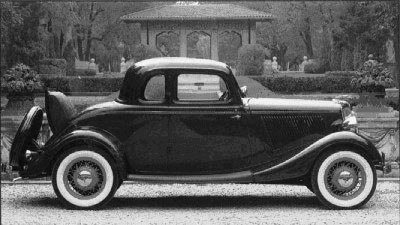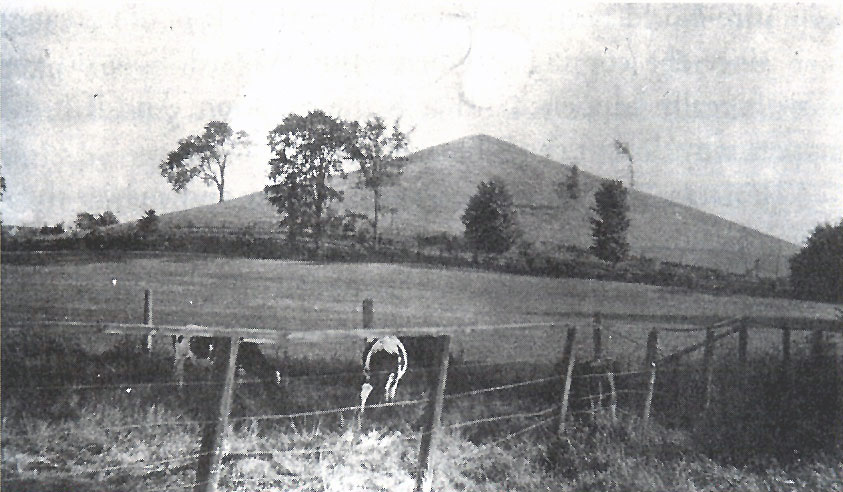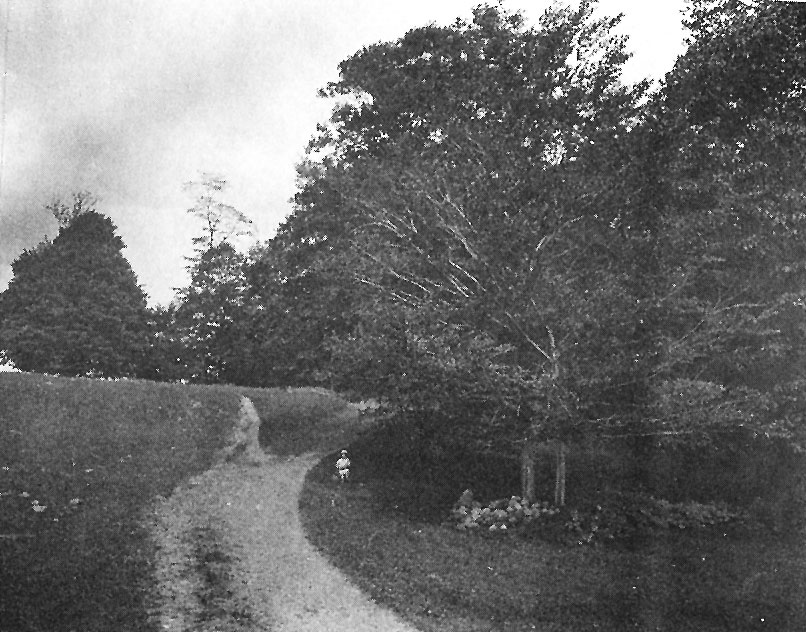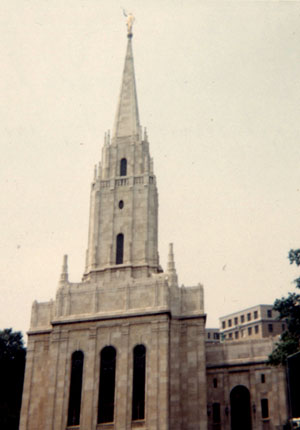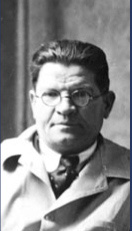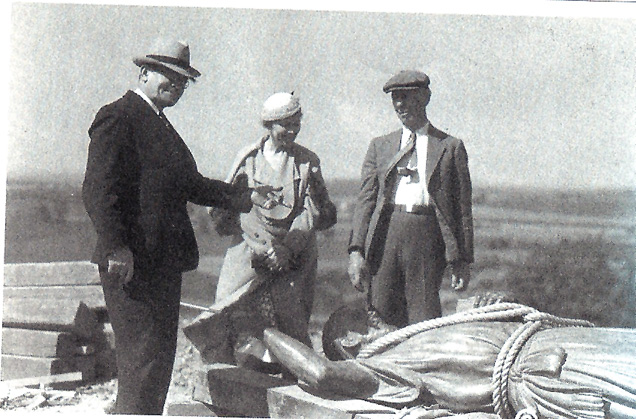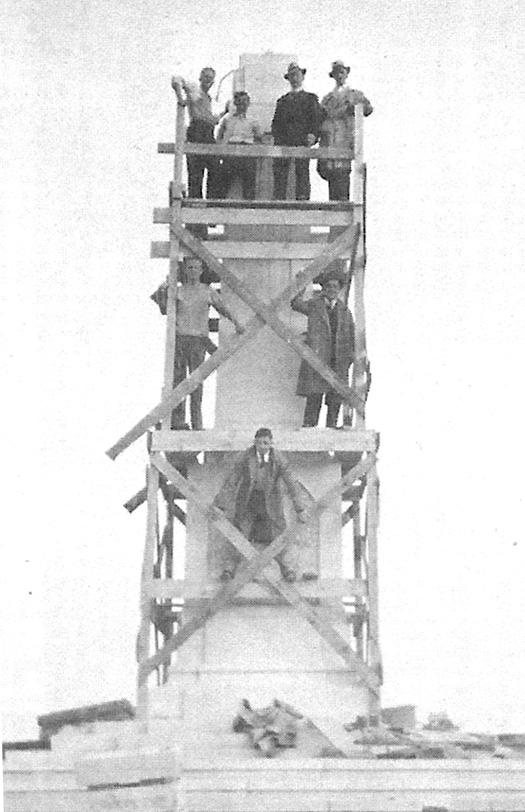The Call
“Brief Description and Impressions of My Trip”
to Hill Cumorah - by Torleif
S. Knaphus – June 1934
|
|
|
Torleif in his studio, circa 1934 |
As a streak of lightning out of a clear sky, it came. I had been working all day on the heroic size clay figure representing Moroni, the last of the ancient American civilized races, had just covered up my work and was ready to leave when a young man came rushing up the stairway asking, “Are you Mr. Knaphus?” I answered, “Yes, it is I.” He said, “It must be very important. Sylvester Q. Cannon wants to see you immediately.”
In the next moment, Architect Lorenzo Young also came rushing up the stairway, grasping hold of
me with both his hands, shaking me the best he could, asking me to let him go
East with me to Hill Cumorah and design the approach for the monument I am
making for that place. He must
have shaken some good sense into my mind as I started thinking, “Well, I have
completed the design for the monument, my vitality is precious to preserve for
the finishing of the art panels, the time is short so your
service will be of great value.” I answered him with these
words: “I am on the way to Bishop Cannon now and will ask him. I think it will be all right.”
A few moments later as I entered the Presiding Bishopric’s Office, I was met by a hearty handshake of Bishop Cannon. He introduced me to his wife and asked me to sit down. He informed me that he was going to Hill Cumorah, that President Colton would meet him there and expressed himself further stating that it would be nice if I could be there at the same time. I said I could. I also put before him the matter in regards to Architect Young and it seemed my petition was timely as two days later it was granted. Two days more of rushing and we were ready to leave.
It was June the 23rd. The days had been hot and more so was it realized when we got on the stuffy train, but we did not care. Sitting down, Mr. Young hit me hard on the knee and expressed, “I wonder what it is all about and what has happened.” After a brief expression of joy suitable for the occasion, our thoughts and conversation was led to the work we were going to do.
As we passed on, smoke and dust became very bad and the next morning we realized we had passed through a sandstorm—layers of dust were all over. We felt the sand between our teeth, it gritted under our feet. However, after washing three or four times, we found we were of the white race and we did not care.
“Cheyenne,” I heard the conductor call. There is music and ring in that very name. It seems as though we can hear the firing guns, the sound of hooves, and the cowboy’s song. As we left Cheyenne going east, it all looked like Wyoming to me. The very formation of the country, the immense stretches of land, rolling hills, white face and other breed of cattle, a few riders, and back of it all you again seem to see the time of old—the wild cowboy rushing to town for excitement, for fun and for play. Late at night you can imagine them leaving, riding silently out over the plains, separating to their different places; sometimes someone hurt, sometimes one lost.
Places we have heard and read about, we form a mental picture of but often after we get there, they look much different. But not so with Wyoming. Wyoming looks ever more so than you can imagine, write or express. As we continued over the plains of Nebraska, seeing a few autoists camping along the roadside, it is with quite a feeling of reverence that we remembered those early Utah pioneers who came this way with ox teams and hand carts.
The following night was very warm as we came through Iowa but in the morning as we arrived in Chicago, it was raining so the air cooled off considerably. From there we took the Greyhound Bus to Detroit. Everything along the road was fresh and delightful, especially as we came into Michigan. We were also much entertained by Lorenzo Young with interesting songs assisted by a young girl from Michigan who had a seat with us. What a thrill and delight the next morning in Detroit when we stepped into Mr. Young’s new ‘34 Model Deluxe Ford, in which we later drove 3,700 miles.
|
|
|
1934 Model Deluxe Ford |
We crossed the Detroit River and came into Canada, taking the new highway along Lake Erie. It was quite a thing to again be on the seashore where you cannot see land across. The road was splendid and so was the surrounding country. My heart was glad to see that the dreadful drought of the West had not been so effectful in the East.
The next morning we spent some time at Niagara Falls, wondering at the immense power of nature, wondering at the creation of God in comparison with that of man, feeling that the very elements and all that is, are made of God and provided for man; that the greatest achievement of man is but as a child showing signs of intelligence as compared with the work of God.
In crossing the line and coming back to the U.S.A., I had some difficulties as I did not bring my citizenship papers. I informed the agent that I was a citizen and lived in Salt Lake City. After asking many questions to prove or disprove my statement, he finally asked if I knew Heber J. Grant. I said, “I do very well.” He had recently had dinner with him and said he was the finest man he had ever met. He then passed me on.
The drive from Niagara Falls south towards Rochester was very beautiful. For miles and miles we drove through fields of fruit. Never before have I seen such an abundance of ripe cherries. It actually spotted the green landscape with orange and red. The very artistic old trees, well placed along the roadside and grouped around white painted farmhouses was wonderful indeed. As I saw the abundance of grapes along the roadside, my thoughts went back thousands of years to the time when my landsmen, the fearless Vikings, the heroes of the seas, led by Leif Erickson came here and how, when they saw the abundance of the wild grapes, they called it “Wineland.” I like those old legends, especially when I know they are true.
As we came to Palmyra, it seemed like coming home. It appears so clean and nice. There are large beautiful shade trees, nicely preserved and well-painted homes and stores. We found the road leading to the Smith Farm and a few minutes later, we were there.
The home was well preserved, well set with full front porch, a few steps above the road. As we stepped over the porch and entered the house, it again seemed like coming home. We met Brother Willard Bean in charge of the Smith Farm and other Church property there. After a few moments conversation, we drove over to Hill Cumorah. As we got the first sight of the Hill, it appeared much finer in contour and line than I ever expected; and as we came nearer, it held its own in beauty and general appearance.
|
|
|
Smith Farm House |
We drove up on the very top and what a wonderful sight it was. Rich fields, rolling hills with groves and farmhouses. As we looked at this glorious landscape, rich and beautiful as it is today, my thoughts flashed back to the ancient American nations who lived and prospered here, to the time they fought their battles and the last great conflict at this place. It was with quite a feeling of reverence that I walked over that ground where heavenly beings had walked and talked to man in this modern time. I felt the importance and responsibility of my visit there, and humbly wished that I would be able to finish the work I was doing in commemorating the restoration of the ancient American records.
|
|
|
Hill Cumorah ca. 1930 |
We proceeded and experimented just where to place the Monument and what way to turn it. We went down, drove up and down the highway, passing the Hill so as to see on which place it would appear the best and back again to the top of the Hill. The sun was then just setting in the West, throwing its last mid-summer glow over the beautiful landscape. The pale full moon had just risen in the eastern sky, giving a beautiful contrast to the warm floating clouds.
We then left the so-historical place and went over to the Sacred Grove where the first and greatest vision of modern times was given, and it was with great reverence that we walked there as we felt it was sacred ground. The time we spent there we will not forget. Later that evening, we went again to Hill Cumorah, driving up and down the highway, viewing the Hill and imagining the monument in silhouette against the bright moon and floating silver clouds.
Coming home we found our room ready. It was the same room Joseph occupied, the room in which Moroni visited him. In the afternoon, Bishop Sylvester Q. Cannon and family arrived, accompanied by Earl J. Glade and his son. The next morning President Colton also arrived, after which we all went to Hill Cumorah.
After spending a few pleasant hours together, deciding on the exact spot for the monument and conversing on other possibilities connected with the Hill, President Colton and Bishop Cannon proceeded on their way to New York.
The next morning I went to the Sacred Grove alone with the intention of painting a picture there but other thoughts came to my mind. I got out some stationary which I carry in my paint box, and wrote to a friend and made notes of my trip.
|
|
|
Entrance to the Sacred Grove ca. 1925 |
The morning was beautiful. As I arrived, the sun had just risen over the eastern hills, the birds were singing all around me, down on the Smith Farm the geese and ducks were gaggling, the big red squirrels were playing leap frog in the tall beautiful trees around me—so rich in variety, so artistically placed. As the bright light from the rising sun broke through the foliage and brought out the beautiful color of the flowers against the rich green, it was wonderful indeed. Every way I turned, it seemed to whisper, “A Sacred Grove,” and when I felt that heavenly peace prevailing there, I expressed “The Sacred Grove, indeed.”
Sunday we attended Sunday School and evening meeting. It was fine to see the kind feeling toward the Mormon people. There is a feeling of interest, many are proud that their fathers knew Brigham Young, Joseph Smith and others. Undoubtedly there will be still greater awakening toward the gospel message in that vicinity.
After many pleasant time and conversations with the Bean Brothers and their most splendid wives; Tuesday noon we were ready to leave. We drove that afternoon through a beautiful country with a continual variety in scenic appearance. The next morning we went through Albany, the capital of New York. I was highly impressed by the House of Commerce which was most splendid in architecture, rich in sculptural ornamentation, made of the beautiful Georgia marble.
The drive along the Hudson River was wonderful. The rich old estates with the most splendid view over the river, the variety of setting and aristocratic old appearance, made quite a contrast to our western homes. The weather was most delightful, the road was splendid and we inhaled richly the enjoyment of it all. We crossed the river at Pepskie and took the Bronx Park Highway to New York—another feast of scenic grandeur for another sixty miles.
Arriving there, we called on some friends of Mr. Young, where we were treated with a most refreshing meal and drink. We later crossed the Bay of Flushing, Long Island and put up at the Stanford Hotel. The next morning and day, we were the guests of Mr. and Mrs. Silver, some other friends of Mr. Young. The morning we spent mostly driving in the fine residential section of Long Island. When we saw such a residence as Mr. Chrysler’s and others, we started to wonder what a luxury and comfort of this modern time.
After a splendid dinner with Mr. and Mrs. Silver, we went to New York where we visited places of interest such as Radio City, the U.S.A Building, and the Empire State Building. As we stood on top of this masterpiece of man, 1208 feet above the street level, looking over the world’s greatest city, with scores of giant office buildings and many thousands of offices, again we wondered at God’s providing means of support for them all. The wind was blowing; the atmosphere was clear so we could see for hundreds of miles in all directions. When you see the many great buildings, railroad depots, parks, bridges, steamships, etc., in such an unusually clear day from that exalted place, it is a sight you will never forget.
|
|
|
New York City
skyline, 1934 – the year Torleif saw it |
The next morning, we went over to the Church head office at Brooklyn. The day was very hot and miserable and still more so was the evening and night. It was with a tender feeling of sympathy that I noticed those poor people along the dusty street and sidewalk in the hot evening, bringing down their chairs and pillows, sitting down along the sidewalk, trying to get some relief from the depressing heat.
|
|
|
Washington, D.C. Chapel Used roughly 1930-1970 |
Next morning we were on our way to Baltimore to see about the L.D.S. Church to be built there. On the way we stopped for some time in Philadelphia, drove through the Park and saw other things of interest. We arrived in Baltimore at 3 o’clock in the afternoon, visited the different sights, met with the building committee, got the job and at 11 o’clock that night we were ready to leave. We stopped at a tourist camp a few miles out.
|
|
|
Angel Moroni that was on the Washington D.C. Chapel by Torleif S. Knaphus |
The next morning, a new feeling of thrill and expectation! As we approached Washington, D.C., the capitol of our great country, we were not disappointed. We planned the day well and saw many things of interest including the splendid L.D.S. Church which is a credit to the Utah people as well as to Washington, being an outstanding
architectural achievement.
We
also visited Lincoln’s Tomb, Washington
Monument, from which top we had a splendid
view over the city, the Shakespeare Library and many other places of interest.
Our ride the following day over the Allegheny Mountains was wonderful. It had a similarity of a great “Great Racer” and the woodland over the mountains was surely grand, continually changing in effect, always thrilling and delightful for hundreds of miles.
At the World’s Fair the following day, we had to plan our time well. I chose to spend the first day in the Art Department and it was to me a great enjoyment and refreshing to the longing for art within me. I spent six hours there. On the 12th street entrance there had been raised a monument in honor of Christopher Columbus and indeed it is a monument worthy of admiration. Why should we not commemorate a man who through much difficulty and poverty accomplished so much for humanity and as I stood there and gazed at that great monument, I was thinking how different it would have been if he had not accomplished what he felt an inner call to do. How much would have been lost? So we see how it behooves every man to find his part in life and do it well. If we all do our part, how grand and wonderful life will be.
The next morning bright and early we went to the Fair and saw the high spots of the last century advancement. The century which has progressed more than all the previous 58 centuries combined. Our hearts did indeed rejoice when we saw what has been done in the lines of electricity, machinery, art and astronomy. They make us realize the great possibilities of man and more fully realize the all-wise God beyond it all who planned and governed the earth, moon and stars.
After a pleasant 370 mile ride through Illinois and part of Iowa, the following day we spent a very pleasant evening with my oldest brother (Lars Kampley – he changed his last name upon immigration to America) at Huxley, Iowa. And not to forget to mention Iowa—it is a very beautiful state with rolling hills, rich fields of corn and many beautiful groves and good homes. The next day my brother went with us to visit, one of my younger brothers (Sakarias Knaphus), living on a big farm at McCallisburg, Iowa. We found them all well and spent a very pleasant time there.
In the evening, we visited with one of my nieces and her family at Des Moines, the capitol of Iowa, and that glorious evening as the sun was low, we set our faces to the West. First over the beautiful rolling country of Iowa, then over the long prairie and plains of Nebraska in the dreadful heat of 108 degrees. The very breeze was hot and suffocating, and again over Wyoming’s gray and dry bluffs.
In less than two days we were home, having driving over 1,000 miles over the great stretches of land our handcart and ox team pioneers struggled their way for many months.
Happy to again be back home and find things well, happy to be back to work and have in that line some valuable tasks to do.
|
|
|
Torleif S. Knaphus June 1934 |
|
One Year Later (June 1935)… |
|
|
|
On Hill
Cumorah with Brother & Sister Bean with whom
Torleif stayed while he was in Palmyra |
|
|
|
|
|
|
Scaffolding around the
obelisk of the
Monument
|
|
 |
|
|
|
Hoisting Angel
Moroni
onto the
monument
|

